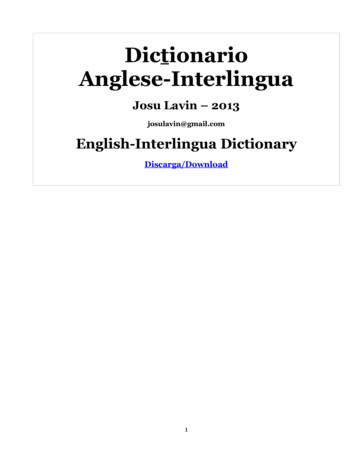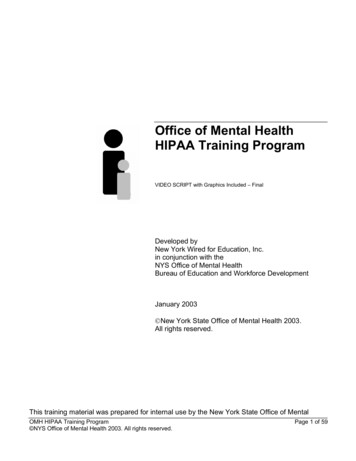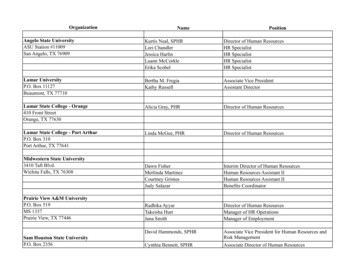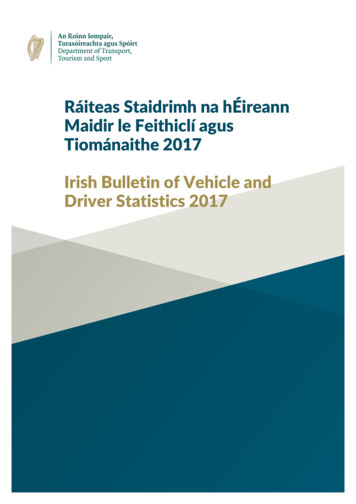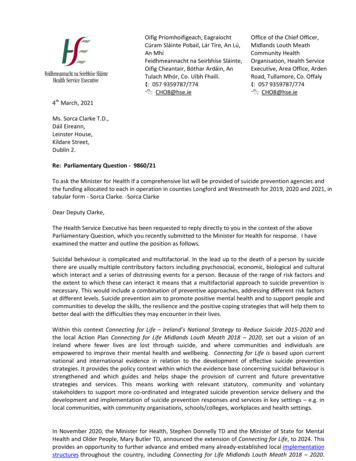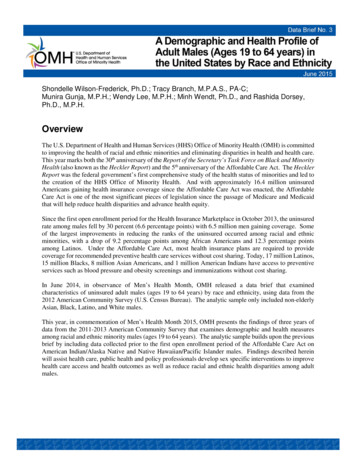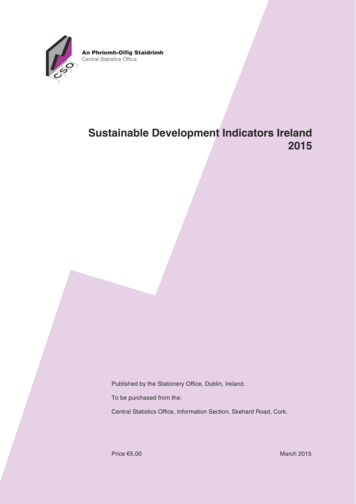
Transcription
An Phríomh-Oifig StaidrimhCentral Statistics OfficePublished by the Stationery Office, Dublin, Ireland.To be purchased from the:Central Statistics Office, Information Section, Skehard Road, Cork.Price 5.00March 2015
Government of Ireland 2015Material compiled and presented bythe Central Statistics Office.Reproduction is authorised, except for commercialpurposes, provided the source is acknowledged.Print ISSNOnline ISSN2009-59532009-5961ISBN978-1-4064-2756-1Cover photographs (from top): Aeration process, waste water treatment plant, Clareabbey, Co. Clare, courtesy of Environmental ProtectionAgency; Kaese primary school, Uganda, courtesy of Irish Aid ; Clones, Co. Monaghan, courtesy of Photographic Unit, National MonumentsAgency; Landfill waste, courtesy of Environmental Protection Agency.
ContentsPageIntroduction . 4Main findings . 5Domains1.Global Indicators . 72.Economy . 133.Social .254.Environment 37Appendix .53Definitions and notes . 54
IntroductionThis is the second edition of Sustainable Development Indicators Ireland, which is published on abiennial basis. The report Our Sustainable Future, A Framework for Sustainable Development forIreland (published by the Department of the Environment, Community and Local Government)requested the CSO to develop a sustainable development indicator set in consultation with othergovernment departments and agencies. The present indicator set, compiled as a response to theDepartment’s request, complements two existing CSO indicator reports namely Measuring Ireland'sProgress and Environmental Indicators Ireland. With a view to minimising the overlap between thesethree indicator sets this report has been limited to 57 indicators.Conceptually, sustainable development has the objective of achieving continuous improvement inquality of life and well-being, by linking economic development, protection of the environment, andsocial justice.The indicators in this publication are presented under four domains: Global Indicators; Economy; Social;and Environment. The Global Indicators domain contains seven indicators and gives a worldwideoverview; the other three domains only contain data for Ireland and the EU. The Global indicators showthat the EU is in an advantaged position in economic, health and education terms relative to most otherregions.The Economy, Social and Environment domains contain indicators designed to show trends in Irelandsince 2000 and to benchmark Ireland against other countries in the European Union. The impacts of the‘Celtic tiger’ and the subsequent recession are clearly visible in the data.The CSO wishes to thank: Birdwatch Ireland; Department of Education and Skills; Department of theEnvironment, Community and Local Government; Department of Finance; Department of Health;Department of Social Protection; Department of Transport, Tourism and Sport; DKM EconomicConsultants; Environmental Protection Agency; Irish Aid; Revenue Commissioners and SustainableEnergy Authority of Ireland for providing us with data and technical advice on the most appropriateindicators for Ireland.Photographs in this publication are supplied courtesy of Irish Aid;, Wendy Kasujja; Environmental Protection Agency; Photographic Unit,National Monuments Service; Irish Green Biofuels Ltd.; An Taisce, and Adrian Redmond.4
Main findings The World population is estimated to reach 7.3 billion persons in 2015 and is forecast to increaseby 10% to 8.1 billion persons in 2025. In Ireland people have around 24 years additional lifeexpectancy compared with people in Africa. European countries donate a higher proportion of theirGross National Income to official development assistance than other economically-developedregions. General government debt in Ireland fell from 79% of GDP in 1995 to 24% in 2006 before increasingto 123% of GDP in 2013. Ireland received a net 1.5 billion from the EU in 2000. In 2013 we received 143 million. In 2013,Germany’s net contribution was over 16 billion while Poland’s net receipts were almost 12 billion. Income tax as a proportion of total exchequer tax revenue decreased from 34% in 2000 to 27% in2006 but then increased to 42% in 2014. In contrast corporation tax increased from 10% in 1995 to15% in 2006 but fell to 11% in 2014. In 2012, persons earning under 20,000 accounted for 9% of total taxable income and paid 0.6% oftotal income tax. Those earning over 100,000 accounted for 23% of total taxable income and paid44% of total income tax. Public sector wages increased from 33% of general government current expenditure in 2000 to36% in 2005 before decreasing to 29% in 2013. In 2000, public sector wages accounted for eight percentage points more of general governmentcurrent expenditure than the proportion accounted for by social welfare payments. In 2009 bothrepresented 32% of the total. Since 2010 social welfare payments have exceeded the cost of publicsector wages, and in 2013 accounted for 32% of total general government current expenditure. In the EU, Ireland had the highest level of completions of residential units per 1,000 persons with arate of 17.8 in 2007. Spain was the next highest at 15.3. By 2014 the rates had fallen to 1.6 inIreland and 1.0 in Spain. In contrast, the rate in Germany has been much steadier at around twocompletions per 1,000 persons during the 2007-2014 period. Emigration levels have increased from a low of 25,300 persons in 1997 to 82,000 persons in 2014.Immigration levels peaked in 2007 at 151,000 persons, before falling to 61,000 persons in 2014. The proportion of children aged 5-12 being driven to school by car increased from 26% in 1986 to61% in 2011. The proportion of children aged 13-18 going to school as car passengers rose from11% to 40% over the same period. In 2011, two out of three persons drove to work. Ireland’s imported energy dependency increased from 69% in 1990 to 89% in 2013. Our importdependency on oil decreased from 66% of total fuel imports in 2005 to 55% in 2013. Our importdependency on gas increased from 20% to 30% over the same period. The number of new private cars registered in either emission band A or B has increased from 12%in 2005 to 95% in 2014. The amount of municipal waste sent to landfill decreased from 2 million tonnes in 2001 to just over1 million tonnes in 2012. The recovery rate of packaging waste increased from 25% in 2001 to87% in 2012.54
1. Global Indicators7
8ContentsIndicatorSourceUnited Nations, Department of Economic and Social Affairs,Population Division (2013). World Population Prospects: The 2012Revision; CSO Census of PopulationUnited Nations, Department of Economic and Social Affairs,Population Division (2013). World Population Prospects: The 2012Revision; CSO Quarterly National Household SurveyUnited Nations Millennium Development Goals Report 2014 StatisticalAnnexUnited Nations Millennium Development Goals Report 2014 StatisticalAnnex; CSO Quarterly National Household Survey1.1World population 2015 and 20251.2Infant mortality and life expectancy 20101.3Population in developing regions living below 1 per day 1990-20101.4Employment rate 20131.5Official Development Assistance 2013Irish Aid annual report 20131.6Net enrolment ratio in primary education 1990-2012United Nations Millennium Development Goals Report 2014 StatisticalAnnex; Department of Education and Skills1.7Greenhouse gas emissions under Kyoto Protocol 1995-2012United Nation Framework Convention on Climate ChangePhotographs: Kaese primary school, Uganda; Agricultural development, Tanzania, both courtesy of Irish Aid; beneficiaries of Social Assistance Grants for Empowerment, Karamoja, Uganda,courtesy of Wendy Kasujja.
1.1 World population 2015 and 20251.2 Infant mortality and life expectancy 2010% of total populationPopulation2015Projectedpopulation2025% change inpopulation2025/2015Under 1515-6465 37410%Africa41%56%3%1,1661,46826%North America19%66%15%3613908%Regiondeaths before age oneper 1,000 live ean25%66%9%43466%South America25%67%8%4154529%Asia %4.65.19%RegionWorldEuropeAfricaNorth America The population of Europe is forecast to fall marginally between 2015and 2025. The highest proportion of under 15s is in Africa, where this age groupcomprises 41% of the population in 2015. Europe has the highestproportion of persons aged 65 and over (17%), and the lowestproportion of persons aged under 15 bbean306974South 82Source: United Nations The highest infant mortality rate in the world in 2010 was in Africa,where 73 infants out of every 1,000 died before reaching their firstbirthday. The rate was 37 infants per 1,000 in Asia, while in moredeveloped regions, the figure falls to around 7 deaths per 1,000. Africa had the lowest life expectancy at birth, both for boys (54 years),and girls (57 years). In contrast, life expectancy in North Americawas 81 years for females and 76 years for males, and in Europe was79 years for females and 71 years for males.1. Global indicatorsThe world’s population is estimated to be 7.3 billion persons in 2015,and is forecast to rise to almost 8.1 billion by 2025. This increase isforecast to occur mainly in Africa, where the population is expected toincrease by 300 million (26%), and Asia, where the population isforecast to grow by over 300 million (11%).Infant mortality rateCentral AmericaIrelandSources: United Nations and CSOlife expectancy at birth (years)9
1.4 Employment rate 2013% of region totalRegion19901999200520102015 GoalDeveloping Regions47%37%27%22%24%5%5%3%1%3%Sub-Saharan Africa57%58%52%48%28%Latin America and Caribbean12%12%9%6%6%East Asia60%36%16%12%30%South Asia52%43%38%30%26%South-East Asia45%36%19%14%23%5%5%5%4%3%10%20%7%4%5%North AfricaWest AsiaCaucasus and Central AsiaSource: United Nations The UN Millennium Development Goals target a halving, between1990 and 2015, in the proportion of persons whose income is lessthan 1 per day. Sub-Saharan Africa reduced the proportion of the population living onless than 1 per day from 57% in 1990 to 48% in 2010.has improved from 52% in 1990 to 30% in 2010.South Asia% of persons employed of total ed Regions62%49%38%Developing Regions75%47%42%North Africa68%18%23%Sub-Saharan Africa71%58%47%Latin America and Caribbean75%50%46%East Asia74%61%50%South Asia77%28%35%South-East Asia79%57%45%West Asia69%20%26%Oceania72%64%52%Caucasus and Central Asia69%51%37%Ireland72%61%:Sources: United Nations and CSONote: Ireland data shows % of people aged 20-64 in employment in 2014. One of the UN Millennium Development Goals is to achieve full andproductive work for all, including women and young people. NorthAfrica (18%) had the lowest female participation rate in 2013 followedby West Asia (20%). Employment rates for youths were substantially lower than elsewherein North Africa (23%) and West Asia (26%).1. Global indicators101.3 Population in developing regions living below 1 per day 1990-2010
1.5 Official development assistance 20131.6 Net enrolment ratio in primary education 1990-2012primary school enrolment rate% of GNINorwaySwedenLuxembourgDenmarkUnited KingdomUN target (0.7% of ermanyAustraliaTotal DACAustriaCanadaNew ZealandIcelandJapanPortugalUnited %85%91%Developed Regions96%97%96%Developing Regions80%83%90%North Africa80%90%99%Sub-Saharan Africa52%60%78%Latin America and Caribbean87%94%94%East Asia97%96%97%South Asia75%80%94%South-East Asia93%93%94%West asus and Central AsiaIrelandSources: United Nations and Department of Education and Skills0.2%0.4%0.6%0.8%1.0% One of the UN Millennium Development Goals is that by 2015, allchildren will be able to complete a full course of primary schooling. While the figure for sub-Saharan Africa has increased from 52% in1990, there were still only 78% of children in this region enrolling inprimary school in 2012.1.2%Source: Irish Aid 1990In 2013, Ireland ranked ninth in the list of OECD DevelopmentAssistance Committee (DAC) donors in terms of their contribution asa percentage of Gross National Income at 0.46%, above the DACaverage of 0.3% of GNI, but below the UN target of 0.7%. Norway, at1.07%, was the largest contributor, relative to its GNI.1. Global indicators0.0%Region11
0002005Base year 1990 10020102012CountryNew orway100107108108105United and101989810687Belgium1051029991829391928481EU 07675United Kingdom9490887875Source: United Nations Of the Annex II countries signed up to the Kyoto Protocol, Australiahad the highest emissions in 2012 relative to the base year of 1990,at 31% above 1990 levels. Ireland’s emissions have fallen since2005, but still remain 6% above 1990 levels. The United Kingdom and Germany had the lowest emissions in 2012,relative to 1990, with both of their indices at 75.1. Global indicators121.7 Greenhouse gas emissions under Kyoto Protocol 1995-2012
2.Economy13
14ContentsIndicatorSource2.1Ireland: General government debt and balance 1995-2013CSO National Accounts2.2EU: Net receipts from EU 2000-2013European Commission2.3EU: Per capita net receipts from EU 2000-2013European Commission2.4EU: General government tax revenue 2012Eurostat2.5Ireland: Exchequer tax revenue 1995-2014Department of Finance2.6Ireland: Income tax distribution 2002-2012Revenue Commissioners2.7Ireland: General government expenditure on pay and social welfare1995-2013CSO National Accounts and Department of Social Protection2.8Euro exchange rates 2001-2014Eurostat2.9Ireland: Gross domestic expenditure on R&D 1995-2013Eurostat and CSO2.10Ireland: Gross fixed capital formation by sector 2000-2013CSO Institutional Sector Accounts2.11EU: Harmonised index of consumer prices for energy products 2014Eurostat2.12Ireland: House completions 1970-2013 and residential property priceindex 2005-2014Department of the Environment, Community and Local Government and CSO2.13EU: Dwelling completions 2007-2014DKM, Euroconstruct, Eurostat, CSO, Department of the Environment,Community and Local GovernmentPhotographs: Biofuel production, courtesy of Green Biofuels Ireland Ltd., Landfill site, courtesy of Environmental Protection Agency.
2.1 Ireland: General government debt and balance 1995-2013 mYearGeneralgovernmentdebt1995% of GDP m140%Debt as %of GDPGeneralgovernmentbalanceBalance as %of 9,96360%40%20%0%General Government Debt-6%% of GDP10%Source: CSO EU 60% GG debt limitGeneral government debt fell from 79% of GDP in 1995 to 24% ofGDP in 2006. It has since risen substantially to 123% of GDP in2013.5%The general government balance was in surplus most years between1995 and 2007, with 2006 showing a surplus of over 5 billion. Since2008, there have been substantial deficits, and the deficit was over32% of GDP in 2010. This was largely due to 30 billion in bankrecapitalisation. The deficit has fallen each year since, and was 6%of GDP in 2013.-10%0%-5%-15%-20%-25%-30%-35%EU 3% Deficit limit2. EconomyGeneral Government Balance15
162.2 EU: Net receipts from EU h landGreeceHungaryPortugalRomaniaCzech 3-3,234-6,476-9,052FranceUnited Kingdom-6,010-3,487-7,914-10,760United Kingdom-11,518-7,852-11,947-16,320Source: European CommissionGermanyGermany Since 2000, eleven EU member states have at some point been netcontributors to the EU budget since 2000. Germany was the largestnet contributor, at over 16 billion in 2013, while Poland was thelargest recipient of funds at almost 12 billion in 2013. 000 mNet receipts from EU 2013-20-16-12-8-4048122. EconomyCountry m2013
2.3 EU: Per capita net receipts from EU 2000-2013Per capita net receipts from EU 2013 per atvia21111297392Czech iaCzech ia-87-44-96-157United 171-267Source: European CommissionNetherlandsDenmarkSwedenOn a per capita basis, Luxembourg was the highest net recipient offunds from the EU in 2013 at 2,377 per capita. Ireland’s net receiptsper capita have fallen from 408 in 2000 to 31 per capita in 2013.Sweden was the largest net contributor to the EU, on a per capitabasis, with 267 in 2013.FranceAustriaUnited 0002. EconomyEconomy2. per capita17
182.4 EU: General government tax revenue 20122.5 Ireland: Exchequer tax revenue 1995-2014DenmarkSwedenFinlandBelgiumItalyUnited inEstoniaBulgariaPolandRomaniaLatviaCzech RepublicLithuaniaSlovakia mYearIncometaxValuedaddedtaxCustomsand 806201442%27%13%11%5%2%41,282Source: Department of Finance05101520253035404550Source: Eurostat % of total tax revenueStampCorporationduties and CapitalTaxresidentialtaxesproperty taxDenmark (47%) had the highest general government tax revenue as apercentage of GDP in 2012. Ireland’s general government taxrevenue (24%) was just below the EU average of 27%. Total exchequer tax revenue increased from 27.1 billion in 2000 to 47.2 billion in 2007, before declining by 15.5 billion between 2007and 2010. Total exchequer tax revenue has since increased to 41.3billion in 2014. Income tax as a proportion of total exchequer tax revenue fell from34% in 2000 to 27% in 2006, before increasing to 42% in 2014. Theincrease between 2010 and 2011 is due to the introduction of theuniversal social charge. Corporation tax as a proportion of total tax revenue grew from 10% in1995 to 15% by 2006, but has fallen since, and accounted for 11% in2014. Capital taxes (Capital gains tax and Capital acquisitions tax)followed a similar trend, where they grew from 1% in 1995 to 8% in2006, and then fell back to 2% in the years 2009 to 2014.2. Economytotal tax receipts as % of GDP
2.6 Ireland: Income tax distribution 2002-2012Income tax distribution 2012% of total income earned% of total income tax paid50%Year0 20,000 20,000 50,000 50,000 100,000Over 100,0000 20,000 20,000 50,000 50,000 100,000Over 20129%36%31%23%0.6%19%36%44%Source: Revenue Commissioners The proportion of total taxable income earned by those with incomes of less than 20,000 per annum fell from 16% in 2002 to 9% in 2012. The proportion of totalincome tax paid by this group fell from 3% in 2002 to 0.6% of the total in 2012While the proportion of total income earned by those in the 20,000 to 50,000bracket has fallen from 42% to 36% between 2002 and 2012, the proportion ofincome tax paid has dropped from 33% of the total to 19%. The proportion of total income earned by cases in the 50,000 to 100,000 perannum bracket has grown from 25% to 31% between 2002 and 2012, and theincome tax paid by this group has increased, from 34% to 36% of total income tax. Income for those cases earning above 100,000 per annum increased from 17% oftotal taxable income in 2002 to 26% in 2008, and has fallen back to 23% in 2012. Inthe same time period, the proportion of tax paid by this group grew from 30% to 47%of the total between 2002 and 2008. It has fallen back to 44% of the total in 2012.25%5%0% 0 - 20k 20k - 50k% of total income earned 50k - 100kOver 100k% of total income tax paid2. Economy 30%19
202.7 Ireland: General government expenditure on pay and social welfare 199520132.8 Euro exchange rates 2001-2014% of GDP180YearWages, salariesand pensionsSocial welfareWages, salariesand pensionsSocial %33%11%12%11%12%201229%32%201329%32%11%12%Sources: CSO and Department of Social Protection 60402002001 2002 2003 2004 2005 2006 2007 2008 2009 2010 2011 2012 2013 2014Government expenditure on wages, salaries and pensions increasedfrom 31% of total current expenditure in 1995 to 36% in 2005. It hassince fallen to 29% in 2013.Government expenditure on social welfare fell from 29% of total currentexpenditure in 1995 to 25% in 2000. It has increased since, to stand at32% of total current expenditure in 2013.US DollarPound sterlingSwiss francChinese yuanJapanese yenSource: Eurostat The euro appreciated significantly against the US dollar between 2001and 2014. Referenced to 2001 100, the Euro was at an index of 148 in2014. The relationship between the Swiss franc and the euro was relativelysteady up to 2009 but the euro declined from an index of 100 in 2009 to82 in 2011, and has remained steady since. The euro weakened againstthe pound sterling and the Chinese yuan by between 10% and 12%respectively between 2009 and 2014, but has strengthened by 8%against the Japanese yen over the same period.2. Economy2001 100% of general government current expenditure
2.10 Ireland: Gross fixed capital formation by sector 2000-20132.9 Ireland: Gross domestic expenditure on R&D 1995-2013IrelandYear m% of GDPEU% of GNP% of ource: CSOEurope 2020 targetSource: Eurostat, CSO Ireland’s expenditure on research and development as a percentage ofGNP has grown from 1.3% in 2000 to 1.9% in 2012. The Europe 2020 target for Ireland is R&D expenditure of 2.5% of GNP by 2020.Gross fixed capital formation of households grew from 8.8% of GDP in2000 to 14% in 2006. It fell substantially since then to 2.9% of GDP in2013.Gross fixed capital formation for the total economy decreased from ahigh of 29.1% of GDP in 2006 to 15.2% of GDP in 2013.2. Economy21
222005 roatia151181155137147147Czech dex 2005 0:Romania164199161148240181United via207233:193 completionsEnergy241205Source: EurostatIn 2014, Ireland, at 50%, was slightly above the average EU increase inconsumer prices of energy goods in the EU between 2005 and 2014.1410,00000Total housing completionsNational residential property price indexSources: Department of the Environment, Community and Local Government and CSO Completions of residential units increased substantially from 21,400 in1994 to a high of over 93,000 units in 2006. Since then, annualcompletions have fallen to 8,300 in 2013. Property prices as measured by the residential property price indexincreased by 14.5% between 2005 and 2007, and then declined by 46%between 2007 and 2012. Prices have since begun to recover, and roseby 13% between 2013 and 2014.2. Economy2.12 Ireland: House completions 1970-2013 and residential property priceindex 2005-20142.11 EU: Harmonised index of consumer prices for energy products 2014
2.13 EU: Dwelling completions 2007-2014per 1,000 populationCountrycompletions per 1,000 1.71.72.02.22.52.7United 22.72.82.82.7Czech Republic4.13.73.73.52.72.82.42.3Czech 3.98.45.53.42.51.41.0FranceSources: DKM, Euroconstruct, Eurostat, CSO, Department of the Environment, Community andLocal GovernmentIreland United nd and Spain had the highest levels of completions of residentialunits per 1,000 persons in 2007 and 2008, but the rate of completions inboth countries has fallen substantially since then.02007There were 1.6 completions in Ireland per 1,000 of population in 2014.This was the fourth lowest level of the 17 EU states for which data 013505520142. Economy 523
3. Social25
26ContentsIndicatorSource3.1Ireland: Employment rate by age class 1990-2014CSO Labour Force Survey and Quarterly National Household Survey3.2Ireland: Unemployment rate 1985-2014CSO Live register3.3Ireland: Emigration and Immigration 1987-2014CSO Census of Population3.4Ireland: Net migration 1951-2014CSO Census of Population3.5EU: People at risk of poverty 2007-2013CSO Survey of income and Living Conditions; Eurostat3.6Ireland: Old age dependency ratio 1996-2046CSO Census of Population3.7Ireland: Persons aged 80 and over 1926-2011CSO Census of Population3.8Ireland: Life expectancy 1901-2006CSO Census of Population3.9Ireland: Recorded criminal offences 2004-2013CSO Crime statistics3.10Ireland: Pupil-teacher ratio 1995-2014Department of Education and Skills3.11EU: Average class sizes 2012Eurostat3.12Ireland: Second level and third level completion rates 1995-2013CSO Quarterly National Household Survey3.13Ireland: Usual means of travel to school 1986-2011CSO Census of Population3.14Ireland: Usual means of travel to work 1981-2011CSO Census of Population3.15EU: Obesity levels 2008United Nations: World Health Statistics 20123.16EU: Alcohol consumption 2010Department of Health; United Nations: World Health Statistics 20123.17EU: Tobacco consumption 2012European Commission Eurobarometer; Health Service ExecutivePhotographs: Clones, Co. Monaghan, courtesy of Photographic unit, National Monument Service; Students from Coosan National School in Co. Westmeath walk to school in May 2014. The schoolis a participant in An Taisce’s Green-Schools Travel programme, which encourages students, teachers and parents to walk, cycle, scoot, use public transport or park ‘n’ stride instead of the privatecar on the school run, courtesy of An Taisce Green-Schools. page
Online ISSN 2009-5961 ISBN 978-1-4064-2756-1 Cover photographs (from top): Aeration process, waste water treatment plant, Clareabbey, Co. Clare, courtesy of Environmental Protection Agency; Kaese primary school, Uganda, courtesy of Irish Aid ; Clones, Co. Monaghan, courtesy of Photographic Unit, National Monuments
